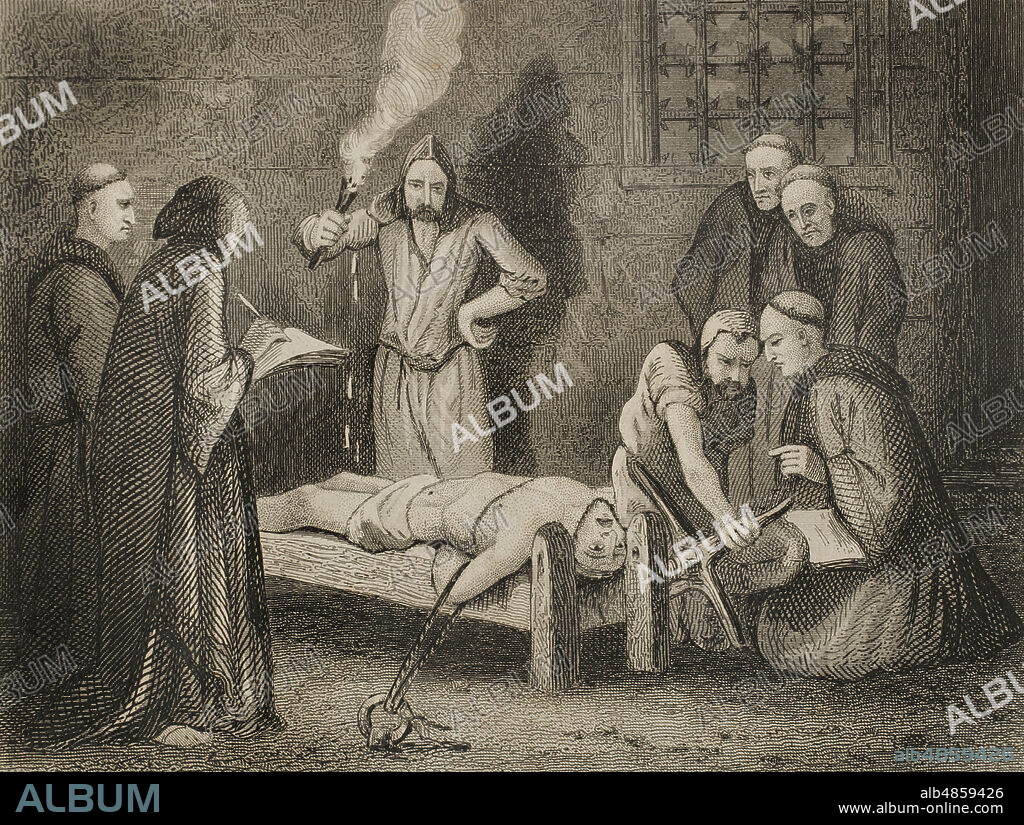alb4859426
Agustín de Cazalla (Agustín de Cazalla Vivero) (c. 1510-1559). Spanish clergyman and member of the Lutheran group of Valladolid. Emperor Charles V appointed him as his chaplain in 1542, taking Cazalla with him the following year to Germany and Flanders, where he preached against heretics with such vigour and zeal that he was admired by all Catholics. The Inquisition imprisoned him on charges that he had been a vocal advocate of Protestant ideas, founding a Protestant group in Valladolid (Castile, Spain). He was subjected to a trial controlled at all times by the Inquisitor General Fernando de Valdés. Cazalla denied all the charges against him, until in the torment he declared that he had turned away from the Catholic religion, saying that he was willing to return to the thinking of the Church if he was allowed to abjure with penance in a public process. The inquisitors flatly refused and condemned him to death. Once in the burner, Cazalla addressed his friends, exhorting them to abandon their doctrines and die in the Catholic religion. In view of the signs of repentance, the inquisitors only allowed him to be garrotted and his corpse to be burnt afterwards. Doctor Cazalla suffering torment. Engraving. Historia de las persecuciones políticas y religiosas en Europa (History of political and religious persecutions in Europe). Volume III. Published in Barcelona, 1864.

|
Zu einem anderen Lightbox hinzufügen |
|
Zu einem anderen Lightbox hinzufügen |



Haben Sie bereits ein Konto? Anmelden
Sie haben kein Konto? Registrieren
Dieses Bild kaufen.
Nutzung auswählen:

Untertitel:
Siehe automatische Übersetzung
Agustín de Cazalla (Agustín de Cazalla Vivero) (c. 1510-1559). Spanish clergyman and member of the Lutheran group of Valladolid. Emperor Charles V appointed him as his chaplain in 1542, taking Cazalla with him the following year to Germany and Flanders, where he preached against heretics with such vigour and zeal that he was admired by all Catholics. The Inquisition imprisoned him on charges that he had been a vocal advocate of Protestant ideas, founding a Protestant group in Valladolid (Castile, Spain). He was subjected to a trial controlled at all times by the Inquisitor General Fernando de Valdés. Cazalla denied all the charges against him, until in the torment he declared that he had turned away from the Catholic religion, saying that he was willing to return to the thinking of the Church if he was allowed to abjure with penance in a public process. The inquisitors flatly refused and condemned him to death. Once in the burner, Cazalla addressed his friends, exhorting them to abandon their doctrines and die in the Catholic religion. In view of the signs of repentance, the inquisitors only allowed him to be garrotted and his corpse to be burnt afterwards. Doctor Cazalla suffering torment. Engraving. Historia de las persecuciones políticas y religiosas en Europa (History of political and religious persecutions in Europe). Volume III. Published in Barcelona, 1864.
Standort:
Privatsammlung
Bildnachweis:
Album / Prisma
Freigaben (Releases):
Bildgröße:
4075 x 3074 px | 35.8 MB
Druckgröße:
34.5 x 26.0 cm | 13.6 x 10.2 in (300 dpi)
Schlüsselwörter:
16. JAHRHUNDERT • 16. JH. • ANGEKLAGTE • ANGEKLAGTER • ANKLAGE • BESCHULDIGEN • BESCHULDIGUNG • BESTRAFUNG • BINDER (FLIEGE) • BINDER • BRAND • CASTILE AND LEON • ERTRAENKEN • ERTRINKEN • ERTRÄNKEN • FACKEL • FENSTER • FOLTER • GARROTTE • GEISTLICHER • GEISTLICHKEIT • GESCHICHTE • GRAVUR • HALSTUCH • HENKER • HINRICHTUNG • INQUISITION • KAPLAN • KARL V, KOENIG • KATHOLISCHE KIRCHE • KATHOLISCHE_KIRCHE • KLEIDUNG: HALSTUCH • KLERIKER • KLERUS • KOENIG KARL V • KRAWATTE • NOYADEN • PRIVATSAMMLUNG • QUAELEREI • QUÄLEREI • RAD • RELIGION • SCHARFRICHTER • SCHMERZ • SEIL • SPANIEN • STICH (KUNST) • STRAFE • STRICK • TOD DURCH ERTRINKEN • TOD DURCH HINRICHTUNG • TOD • TODESFALL • TODESSTRAFE • TODESURTEIL • TÖTEN • VALLADOLID • WASSERLEICHE • ZEITGESCHICHTE


 Pinterest
Pinterest Twitter
Twitter Facebook
Facebook Link kopieren
Link kopieren Email
Email
